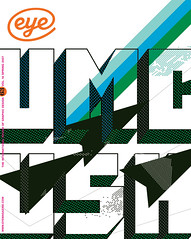Spring 2007
Where is the love?
Letter from Rian Hughes, Devicefonts
Re ‘Art bollocks’: some insights and a dose of clarity can be arrived at by comparing the art scene to the music scene. What are the differences and similarities?
Music communicates directly, as an inextricable part of people’s emotional lives – go to a concert and you see how powerful and meaningful it can be. Music is easily delivered into our private spaces, and isn’t mediated by the equivalent of galleries or curators. It’s democratic and meritocratic. Music articulates the ideas of an era. It edifies, illuminates and communicates, and can do so powerfully and emotionally. People LOVE their music. Sadly, much ‘gallery’ art does none of the above. Instead, it confuses, deadens, excludes; fails to communicate effectively or clearly; uses bombast rather than finesse for emotive effect; says (to quote Morrissey) ‘nothing to me about my life’. Love is not an adjective many would use to describe their relationship with contemporary art.
So where is the visual art that does have this love effect? Work that communicates emotively, powerfully, that people respond to with something like the love they have for music. That can make the hairs on the back of your neck stand up like they do when you hear the key change in a classic pop song? That art is graphics: design and illustration.
Maybe Warhol and Lichtenstein were effectively saying, ‘Look at this stuff outside the gallery’, and in so doing passed the baton to designers and illustrators because they realised that that is where the really interesting work was happening. The work of ‘commercial artists’ from, say, the psychedelic Fillmore West posters, through Jamie Reid and TDR to the present day, have had more to say about their times (and have pushed the visual experiment much further) than the fine art world has.
Maybe it’s just that fine art stopped being interested in the Visual, and went off to explore something else. That’s its prerogative. Those other concerns – colour, composition, ideas, beauty, craftsmanship, clarity, communication and technical excellence – were now the purview of commercial artists, designers and illustrators like the ones just mentioned. And that’s why I love them.
London
First published in Eye no. 63 vol. 16 2007
Eye is the world’s most beautiful and collectable graphic design journal, published quarterly for professional designers, students and anyone interested in critical, informed writing about graphic design and visual culture. It is available from all good design bookshops and online at the Eye shop, where you can buy subscriptions, back issues and single copies of the latest issue. You can also browse visual samples of recent issues at Eye before You Buy.

